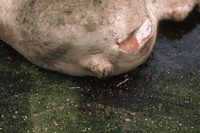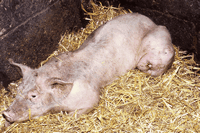NADIS Pig Disease Focus – December 2006
| NADIS is a network of 40 veterinary practices and six veterinary colleges monitoring diseases of cattle, sheep and pigs in the UK. |
| NADIS data can highlight potential livestock disease and parasite incidences before they peak, providing a valuable early warning for the month ahead. |
| NADIS disease bulletins are written specifically for farmers, to increase awareness of prevalent conditions and promote disease prevention and control, in order to benefit animal health and welfare. Farmers are advised to discuss their individual farm circumstances with their veterinary surgeon. |
NADIS Pig Disease Focus – December 2006
Whole Carcass Condemnation
Mark White BVSc DPM MRCVS
The post mortem meat inspection process undertaken within all abattoirs is intended to identify and reject any meat that is deemed unfit for human consumption. As a result many plucks (liver, heart and & lungs) of slaughter pigs are rejected along with parts of carcasses such as heads, individual legs, skins etc. A typical commercial farm in the UK is not penalised by the abattoir for pluck condemnations but trimmings can account for an average 2kg in every 1000kg slaughtered (0.2%) being deducted.
Furthermore many carcasses that require trimming are also downgraded with a financial penalty imposed on the whole carcass. This can be worth more than £5/pig on top of the lost weight.
Pig farmers, however, are more commonly concerned when whole carcasses are rejected – losses that ought to be added to the on farm mortality figures as constituting unmarketable animals. Unfortunately information supplied to farmers with respect to rejected carcasses is often delayed, vague and illegible. The aim of this note is to briefly outline the most common causes of whole carcass condemnations and review the likely underlying causes to enable control measures on farm to be drawn up and to allow better selection of stock for slaughter. It is technically an offence to submit an animal for slaughter for human consumption knowing it to be unfit although in practice this largely relates to treated animals that have not passed the full meat-withholding period for the medicine used.
According to the Meat Hygiene Service figures, 3.5 whole pig carcasses in every 1000 slaughtered were rejected and condemned in 2005. The most common conditions described leading to rejection are shown below and a brief description of the more common causes is required.
1. Pyaemia/generalised abscessation
2. Oedema/Emaciation
3. Fever/Septicaemia/Toxaemia
1. Pyaemia
Where a single abscess is found in the carcass it would lead to trimming and rejection of the affected area. However, where more than one abscess is present, even if in diversely different parts of the body, there is usually a presumption that there has been spread from one to the other via either the blood stream or the lymphatic system. The implication is that bacterial infection might have spread throughout the body and this renders the whole carcass unfit for human consumption. It is therefore necessary to attempt to identify what might have caused an initial focus of infection in the body leading to the primary abscess, which then spreads.
The simple answer to such a question is any penetration of the body’s integrity either through the skin or the mucosal surfaces (e.g. penetration within the mouth or oropharynx).

Fig1: This healed tail bite lesion was associated with multiple internal abscessation (pyaemia) Typically such lesions could be the result of: –
1) Fight wounds leading to primary subcutaneous abscessation
2) Abrasion of feet and legs resulting from rough floors etc e.g. ulcerative bursitis.
3) Dirty injection techniques setting up primary abscessation in muscle tissue.
4) Tail and ear biting lesions particularly where these occur early in life and the lesion itself has largely or totally healed by the time the pig reaches slaughter weight. Therefore tail damage may not be evident even after dressing of the carcass. (Fig 1).
5) Ear tip necrosis early in life.
6) Septic pleurisy. Since the arrival of PMWS on most UK farms there has been a rise in severe pleurisy lesions, which in the most severe form can set up abscessation within the musculature of the rib cage. If restricted to this area, trimming may be possible with only partial carcass rejection. Where infection has spread beyond the thorax (chest) whole carcass condemnation is likely.
On many farms incurring only the occasional case of ‘pyaemia’ at slaughter it is too late to identify the underlying cause back at the farm. However, where cases occur at a more regular rate investigations of the whole growing herd may be needed to identify possible underlying causes. Nationally, ‘pyaemia’ accounted for 55% of carcasses wholly rejected at slaughter in 2005.
2. Septicaemia
Septicaemia refers to presence of pathogenic bacteria within the blood stream i.e. represents an earlier stage of infection than multiple abscessation that may result from it.
An acutely septicaemic pig will be ill – usually depressed, pyrexic and inappetant. Such animals should never be loaded for slaughter, but if they are, they are likely to be detected at ante mortem inspection and rejected at that point.
Carcasses that are described as septicaemic will tend to have chronic lesions in the chest and abdomen (in the absence of pus) and would more accurately be described as polyserositis. Glassers Disease (Haemophilus parasuis infection) in the young grower is likely to be the cause of most such cases.
3. Polyarthritis/Arthritis
Arthritis is inflammation of the joints and can be septic (purulent), non-infectious or non purulently infected.
Where a single joint is affected and provided there is no evidence of spread of infection from or to the joint, rejection is likely to be restricted to the affected leg only. Where more then one joint is affected it is likely that the whole carcass will be rejected and the reason given as generalised abcessation.
The most common cause of single septic arthritis joints (Fig 2.) is previous tail biting with bacterial spread to the joint. Such cases should not be submitted for slaughter for human consumption but if they are, they are likely to be rejected on the grounds of pyaemia.
Some cases of polyarthritis – if not septic – are likely to be reported as septicaemia

Fig 2: A single joint severely affected with septic arthritis – such a pig should never be submitted for slaughter for human consumption but surprisingly some are – especially if not discharging as seen here
4.Oedema
Oedema is the accumulation of fluid within the tissues and where it occurs in muscle it renders the carcass unfit for human consumption. There are a number of possible causes of oedema in the carcass:
a) Emaciation – poor condition pigs lack circulating protein which is required to maintain the correct fluid balance between the bloodstream and the peripheral tissues. As the outlets for casualty pigs continue to decline it would be expected that the incidence of such pigs being offered for slaughter would decrease
b) Hypoproteinaemia – the sudden reduction in circulating protein in an outwardly ‘normal’ pig. The most likely cause of this is the massive protein loss that occurs through the kidneys in acute PDNS. It should be remembered that renal damage can occur without the typical skin lesions associated with PDNS.
c) Congestive Heart Failure. This results in pressure build-up in the venous return system and creates leakage of fluid in peripheral tissues. In modern pig production the most likely cause of such problems in an otherwise apparently normal pig is constriction of the heart by chronic pericarditis lesions commonly seen at slaughter.
5. Miscellaneous
There are a whole range of “one off” conditions including lymphosarcoma, melonosis, anaemia that would render a carcass unfit for human consumption but these are of limited economic significance and generally require no on farm action.
Conclusions
Unfortunately the information available to the pig farmer as to the detail of carcass rejection is sketchy, delayed and confusing. Where regular problems are experienced it is well worthwhile requesting the farms own veterinary surgeon attend the abattoir to undertake a detailed examination of any detained carcasses. It should be highlighted that the nature of the BPEX pig health scheme recording system precludes recording of the worst carcasses in most plants as material is not usually presented from such carcasses on the normal slaughter line – it will not be dressed in the usual way and will be directed off the line into a detention or rectification area.
Copyright © NADIS 2007 www.nadis.org.uk





